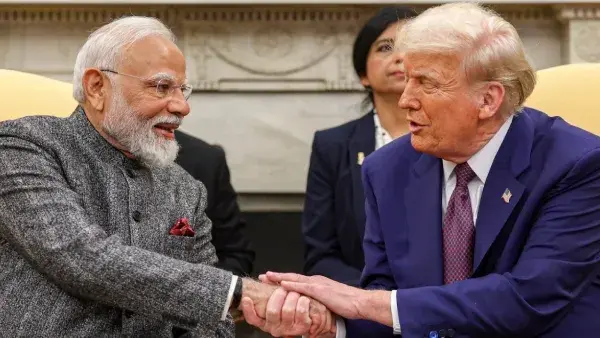Trump Reciprocal Tariffs are forcing Asian nations, including India, to navigate difficult choices and economic uncertainty after US President Donald Trump confirmed that the policy will apply to “all countries.”

This has put an end to rumors that he could initially restrict the tariffs’ first application. The tariffs are scheduled to be implemented on April 2.
For a region whose economies have historically depended on exports to the United States and a worldwide system of minimal trade barriers, the planned tariffs offer a significant challenge.
“You’d start with all countries, so let’s see what happens,” Trump said to reporters on Air Force One today.
I haven’t heard any rumors concerning ten or fifteen countries.
As part of his plan to encourage American manufacturing, rebalance international trade, and raise money to fund his domestic objectives, the US president is getting ready to implement “reciprocal tariffs” on April 2.
What reaction ought India to have to Trump’s strategy of reciprocal tariffs?
Continue negotiating. Ask the US for additional trade concessions.
Accept reductions in tariffs. Lower taxes to obtain exemptions
Apply counter-tariffs to US goods as a form of tariff retaliation.
Reduce dependence on US trade by diversifying your trading partners.
These include carrying out more tax-related promises from his 2024 campaign and extending tax reduction from his first term
The White House has not yet disclosed which tariffs would be implemented, how they will be determined, or the requirements that nations must fulfill in order to be granted exemptions.
Additionally, Trump has indicated that non-tariff obstacles will be considered, although he has not made it clear how this will be determined. Furthermore, no formal date for the implementation of these tariffs has been given.
“We’re going to be much nicer than they were to us, but it’s substantial money for the country,” Trump said.
Trump Reciprocal Tariffs: What Is Donald Trump Planning?
Trump plans to unveil import taxes, including “reciprocal” tariffs that would equal other nations’ rates and take into consideration different subsidies, according to Reuters.
Trump has stated that he is thinking of imposing similar taxes on countries including Brazil, South Korea, the European Union, and India.
Trump Reciprocal Tariffs: How Is India Responding to the Policy?
Trump Reciprocal Tariffs: India Takes a More Accommodative Stance Than China, Canada, and the EU, Willing to Lower Tariffs on Half of $23 Billion US Imports.
Tariff reductions and negotiations
According to Reuters, which cited two government officials, India has suggested reducing duties on US agricultural exports, such as cranberries and almonds, as a gesture of goodwill.
During discussions in New Delhi with Brendan Lynch, the Assistant US Trade Representative for South and Central Asia, India agreed to reduce tariffs on bourbon whiskey and agricultural imports such as almonds, walnuts, cranberries, pistachios, and lentils, the report added.
During discussions in New Delhi with Brendan Lynch, the Assistant US Trade Representative for South and Central Asia, India agreed to reduce tariffs on bourbon whiskey and agricultural imports such as almonds, walnuts, cranberries, pistachios, and lentils, the report added.
The Hindustan Times reports that the United States and India just wrapped up their first face-to-face trade talks with “significantly positive outcomes.” India could be able to obtain exemptions from the retaliatory tariffs that Washington intends to impose on April 2 thanks to these developments.
A general consensus on the framework for negotiating a Bilateral Trade Agreement (BTA) was reached after four days of talks that started on Wednesday and were extended by one day. The two countries talked about expanding market access and lowering tariff and non-tariff obstacles, according to India’s Commerce Ministry.
Officials involved in the negotiations highlighted several positive takeaways from the talks.
“First, an additional day was added to the bilateral trade negotiations in New Delhi. Second, the two decided to use virtual mode to move their conversation to the next level. Thirdly, other nations like China, Canada, Mexico, Germany, and the European Union are retaliating, while India is the only one negotiating a mutually advantageous BTA with the USA. One official, who spoke to the media on condition of anonymity, concluded by praising President Trump’s remarks about India.
Regarding Trump reciprocal tarffis remarks at the White House on Friday, PTI said that he called Prime Minister Narendra Modi a “very smart man” and his “great friend,” adding that he was confident the trade talks between the US and India will be settled in a favorable way.
In keeping with the vision set forth by the leaders of both countries, the talks were held in what authorities characterized as a “friendly and cordial atmosphere with shared purpose,” with the goal of reaching an agreement by September of this year.
Policy changes
India has removed the 6% “Google tax” on web ads in an effort to conform to US trade expectations. Global technology companies who operated in India without a physical presence had previously faced difficulties as a result of this levy. According to the Financial Times, the elimination of this fee is thought to be a move toward promoting more amicable trade negotiations and maybe averting US penalties.
Modi’s US visit
President Donald Trump and Prime Minister Narendra Modi reaffirmed their commitment on February 13 to bolstering trade relations between the United States and India in a way that fosters job creation, national security, and economic progress. Under the Mission 500 plan, they aim to increase total bilateral trade from about $200 billion to $500 billion by 2030.
Conclusion
Trump Reciprocal Tariffs set to take effect on April 2, 2024, mark a significant shift in global trade policies. India, while taking a more accommodative stance than other nations, is preparing strategic responses to minimize economic disruptions. By negotiating tariff reductions and exploring alternative trade routes, India aims to balance its economic interests while maintaining stable relations with the U.S. However, the long-term impact of these tariffs on key industries, exports, and overall trade dynamics remains uncertain. As the trade war showdown unfolds, India’s approach will play a crucial role in shaping its economic resilience and future trade agreements.















